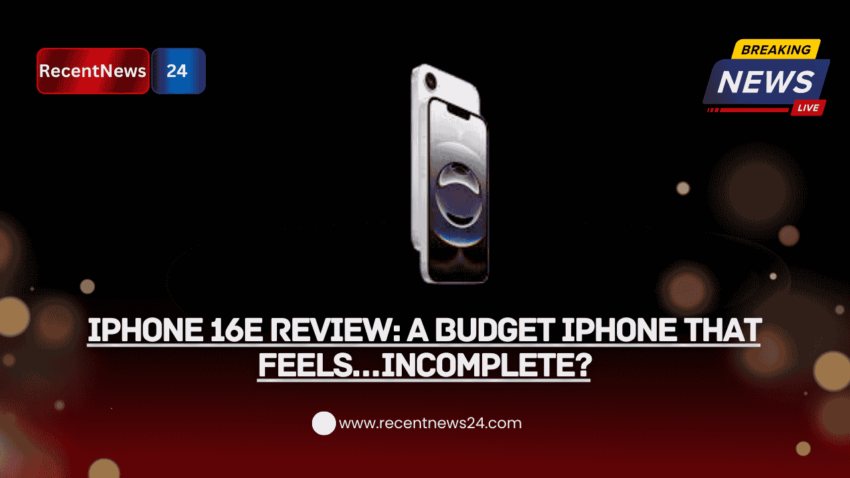iPhone 16e Review: A Budget iPhone That Feels…Incomplete?
The iPhone 16e is Apple’s cheapest new iPhone, but it’s not cheap. At $599, it has most of the core iPhone features, including Apple Intelligence, but cuts enough corners to leave many people wondering—who is this phone for?
Let’s break down the design, camera, performance, and features to see if the iPhone 16e is worth your money.
What Does the “E” in iPhone 16e Stand For?
📌 Essential? Easy? Extra? Even Apple hasn’t clarified what the “E” means, but it feels like a stripped-down iPhone 16, missing some features that might be deal-breakers for some users.
iPhone 16e vs. iPhone 16: What’s Missing?
While both phones share Apple’s A18 chip and a 48MP camera, the 16e cuts several features to bring the price down by $200.
What You Lose with the 16e:
🚫 No Ultra-Wide Camera → No macro photography; have to physically step back for wider shots.
🚫 No MagSafe → Wireless charging still works, but no MagSafe accessories like wallets or docks.
🚫 No Dynamic Island → You can’t track sports scores, Uber rides, or FaceTime calls like on the iPhone 16.
🚫 No Camera Control on Action Button → The Action Button is here, but you can’t use it to open the camera.
🚫 No Ultra-Wide Band → Finding AirTags or lost AirPods is less precise.
🚫 No Cinematic Video Mode → Video recording is slightly limited.
🚫 Wi-Fi 6 instead of Wi-Fi 7 → Older Wi-Fi standard, but not a huge deal for most.
🚫 A18 Chip Has One Less GPU Core → Won’t matter for everyday use, but could impact heavy gaming or AI tasks.
What You Still Get:
✅ 48MP Main Camera → Still takes high-quality photos.
✅ A18 Chip → Fast performance for daily tasks and gaming.
✅ Great Battery Life → Lasts all day with normal use.
✅ Action Button → Customizable, but missing some features.
✅ Apple Intelligence → (More on that later…)
📌 The Real Question: Is the missing MagSafe, Dynamic Island, and Ultra-Wide Camera worth saving $200?
C1 Modem: A Big Wild Card
One of the biggest unknowns going into testing was Apple’s first in-house modem, the C1. Unlike Qualcomm modems in previous iPhones, the C1 is brand new—and Apple reportedly had major issues developing it.
📌 If this modem was bad, the 16e would be DOA.
Real-World Performance:
📡 Tested on Verizon & AT&T in multiple locations → No major issues.
📡 FaceTime calls in basements & crowded areas → Worked just as well as iPhone 16.
📡 Streaming videos, speed tests, and 4K uploads → Similar speeds to iPhone 16.
🔹 Verdict: The C1 modem is fine, but not noticeably better or worse than Qualcomm modems.
Does the iPhone 16e Feel Too Expensive?
The biggest issue with the iPhone 16e is that it feels like an iPhone SE replacement—but at $600 instead of $500.
📌 If Apple had priced this at $499, it would be an easy recommendation.
Instead, we got a $600 iPhone that lacks a core feature like MagSafe—even though the iPhone 13 Mini had it years ago.
💡 If the “E” stands for Essential, why is MagSafe missing?
Apple Intelligence: The Big AI Push (That’s Not There Yet)
Apple wants AI to be a major selling point, but the reality is that Apple Intelligence isn’t that useful yet.
🔹 AI features in iOS 18 are limited compared to Google’s Pixel AI tools.
🔹 Apple’s AI needs more time to develop into something people actually rely on.
💡 Right now, Apple Intelligence is more of a “nice to have” rather than a “must-have.”
Final Verdict: Should You Buy the iPhone 16e?
✅ Buy It If:
✔ You want the cheapest new iPhone with modern features.
✔ You don’t care about MagSafe, Dynamic Island, or an Ultra-Wide Camera.
✔ You need good battery life and a solid main camera.
🚫 Skip It If:
❌ You expected an iPhone SE 4 for $500.
❌ You already have an iPhone 13, 14, or 15 (not a huge upgrade).
❌ You want MagSafe or Dynamic Island—both missing here.
❌ You’d rather buy a used/refurbished iPhone 15 or iPhone 14 Pro for the same price.
💡 Final Thought:
The iPhone 16e is a solid phone, but Apple priced it too high. If you’re spending $599, you might as well buy a refurbished iPhone 15 Pro for a better screen, MagSafe, and an extra camera.






